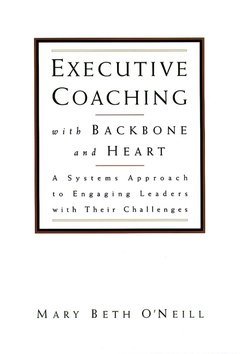Description
Executive coaching backbone
Author: ONEILL
Language: English
Approximative price 40.80 €
Subject to availability at the publisher.
Add to cart
Publication date: 02-2000
224 p. · 23.4x15.7 cm
224 p. · 23.4x15.7 cm
Description
/li>Contents
/li>
Coaching high powered executives requires something special, something extra. Executive coaches must be more than instructors, they must become partners whose emotional investment in business outcomes equals that of their clients. They must have the strength and courage to face an organizational leader in a time of crisis and speak the unvarnished truth. They have to be a force to be reckoned with. They have to have backbone and heart.
Mary Beth O'Neill has backbone and heart, and she's used it to help executives become better leaders and make better business decisions for more than twenty years. In this book, she shares the secrets of her success as she details the techniques she's developed over the course of her exceptional career.
O'Neill knows first hand that executive coaching is about self management, about learning how to be with leaders so you can seize those critical moments when they are most open to learning. She focuses on the need for coaches to build their own signature presence with clients and outlines four conditions that promote such a presence.
The author also teaches coaches how to deal with clients in terms of the "force fields" they create and react to, that is, the political and emotional climates within organizations that can ensnare both executive and coach and make for faulty decision making. In so doing, O'Neill introduces an important new systems approach to executive coaching.
O'Neill reinforces her observations on coach self management and her systems perspective with a sound four phase methodology for implementing both, a methodology that covers contracting, planning, live action intervening, and debriefing. She also addresses special applications such as how to guide conversations that establish coaching relationships and how a coach can help executives coach others.
Mary Beth O'Neill has backbone and heart, and she's used it to help executives become better leaders and make better business decisions for more than twenty years. In this book, she shares the secrets of her success as she details the techniques she's developed over the course of her exceptional career.
O'Neill knows first hand that executive coaching is about self management, about learning how to be with leaders so you can seize those critical moments when they are most open to learning. She focuses on the need for coaches to build their own signature presence with clients and outlines four conditions that promote such a presence.
The author also teaches coaches how to deal with clients in terms of the "force fields" they create and react to, that is, the political and emotional climates within organizations that can ensnare both executive and coach and make for faulty decision making. In so doing, O'Neill introduces an important new systems approach to executive coaching.
O'Neill reinforces her observations on coach self management and her systems perspective with a sound four phase methodology for implementing both, a methodology that covers contracting, planning, live action intervening, and debriefing. She also addresses special applications such as how to guide conversations that establish coaching relationships and how a coach can help executives coach others.
Preface Acknowledgements The Author
Part One: Core Concepts: The Coach's Stance
1. An Introduction to Executive Coaching
2. Developing a Strong Signature Presence
3. Systems Thinking: Understanding Challenges of the Executive Coach
4. The Triangled Coach: Being Effecitve in the Middle
Part Two: The Four Phases of Coaching
5. Phase 1
Contracting: Find a Way to Be a Partner
6. Phase 2
Action Planning: Keep Ownership with the Client
7. Phase 3
Live Action Coaching: Strike When the Iron is Hot
8. Phase 4
Debreifing: Define a Learning Focus
Part Three: Special Applications
9. Making a Strategic Transition to the Role of Executive Coach
10. Helping Leaders Effectively Coach Employees
Part One: Core Concepts: The Coach's Stance
1. An Introduction to Executive Coaching
2. Developing a Strong Signature Presence
3. Systems Thinking: Understanding Challenges of the Executive Coach
4. The Triangled Coach: Being Effecitve in the Middle
Part Two: The Four Phases of Coaching
5. Phase 1
Contracting: Find a Way to Be a Partner
6. Phase 2
Action Planning: Keep Ownership with the Client
7. Phase 3
Live Action Coaching: Strike When the Iron is Hot
8. Phase 4
Debreifing: Define a Learning Focus
Part Three: Special Applications
9. Making a Strategic Transition to the Role of Executive Coach
10. Helping Leaders Effectively Coach Employees
© 2024 LAVOISIER S.A.S.




